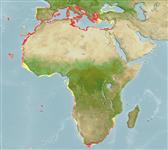>
Eupercaria/misc (Various families in series Eupercaria) >
Sparidae (Porgies)
Etymology: Sarpa: Spanish, sarpo, sapo = toad; a toad-fish (1753) (Ref. 45335).
More on author: Linnaeus.
Environment: milieu / climate zone / depth range / distribution range
Écologie
marin; saumâtre benthopélagique; océanodrome (Ref. 51243); profondeur 5 - 70 m (Ref. 3688). Subtropical; 45°N - 40°S, 26°W - 36°E
Eastern Atlantic: Bay of Biscay and Strait of Gibraltar to Sierra Leone, including Madeira, the Canary Islands, and Cape Verde; Congo to South Africa. Also present in the Mediterranean.
Length at first maturity / Taille / Poids / Âge
Maturity: Lm 16.5 range ? - ? cm
Max length : 51.0 cm SL mâle / non sexé; (Ref. 3397); common length : 30.0 cm SL mâle / non sexé; (Ref. 4781)
Épines dorsales (Total) : 11 - 12; Rayons mous dorsaux (Total) : 14 - 17; Épines anales: 3; Rayons mous anaux: 13 - 15. Black spot at the pectoral fin base. Body relatively slender with 10 golden longitudinal stripes (Ref. 35388).
Found over rocky substrates and sandy area with algal growth. Gregarious, sometimes forming sizeable schools. Young mainly carnivorous on crustaceans, adults almost exclusively herbivorous (Ref. 4781), feed on seaweeds (Ref. 36731). Protandric hermaphrodite (Ref. 4781). Tasty when fresh, but easily softens and is not much esteemed (Ref. 3198).
A monandric species (Ref. 55367). Sex change occurs at 25.0 cm TL and 3.75 years of age (Ref. 55367). Conflicting descriptions of the reproductive style of this species have been reported, including possible gonochorism (Ref. 103751). Also Ref. 28504.
Bauchot, M.-L. and J.-C. Hureau, 1990. Sparidae. p. 790-812. In J.C. Quero, J.C. Hureau, C. Karrer, A. Post and L. Saldanha (eds.) Check-list of the fishes of the eastern tropical Atlantic (CLOFETA). JNICT, Lisbon; SEI, Paris; and UNESCO, Paris. Vol. 2. (Ref. 3688)
Statut dans la liste rouge de l'IUCN (Ref. 130435)
Menace pour l'homme
Harmless
Utilisations par l'homme
Pêcheries: commercial; pêche sportive: oui; appât: occasionally
Outils
Articles particuliers
Télécharger en XML
Sources Internet
Estimates based on models
Preferred temperature (Ref.
123201): 15.3 - 24, mean 18.8 °C (based on 232 cells).
Phylogenetic diversity index (Ref.
82804): PD
50 = 1.0000 [Uniqueness, from 0.5 = low to 2.0 = high].
Bayesian length-weight: a=0.01230 (0.01109 - 0.01364), b=3.04 (3.01 - 3.07), in cm total length, based on LWR estimates for this species (Ref.
93245).
Niveau trophique (Ref.
69278): 2.0 ±0.0 se; based on diet studies.
Résilience (Ref.
120179): Faible, temps minimum de doublement de population : 4,5 à 14 années (tmax=15; tm=2; K=0.20-.027;).
Prior r = 0.30, 95% CL = 0.20 - 0.45, Based on 4 data-limited stock assessments.
Fishing Vulnerability (Ref.
59153): Moderate vulnerability (41 of 100).
Climate Vulnerability (Ref.
125649): Low to moderate vulnerability (32 of 100).
Nutrients (Ref.
124155): Calcium = 64 [31, 129] mg/100g; Iron = 0.921 [0.492, 1.748] mg/100g; Protein = 19 [17, 21] %; Omega3 = 0.253 [0.129, 0.524] g/100g; Selenium = 28.6 [13.5, 56.9] μg/100g; VitaminA = 12.5 [3.3, 38.3] μg/100g; Zinc = 1.27 [0.88, 1.85] mg/100g (wet weight); based on
nutrient studies.
